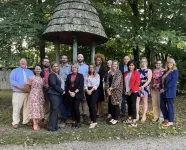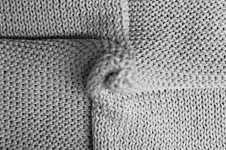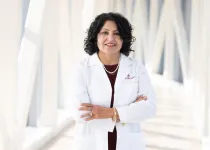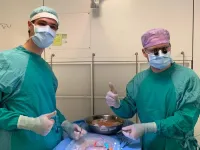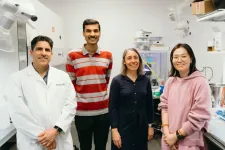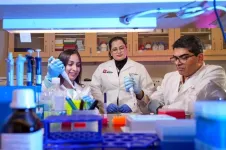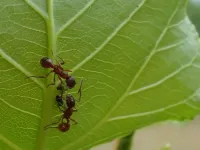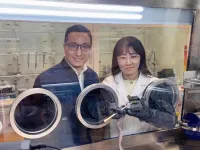(Press-News.org) During and after the height of the COVID-19 pandemic, telehealth appointments became a more common part of the American health care system. But even as telehealth options grow, barriers such as long waitlists or a lack of a stable internet connection mean many communities still do not have access to care, particularly for mental health services.
The University of Cincinnati, the Adams County Health Department (ACHD) and other local partners are testing a new collaborative care model that aims to remove these barriers and provide more students access to telemental health care. The team recently received a $1.75 million grant from the Health Resources and Services Administration (HRSA) to continue a project called Operation Better Together that could become a model for rural communities nationwide.
Getting everyone to the table
In 2017, the ACHD conducted a community health assessment that for the first time found that mental health and substance abuse were the leading public health problems in the south-central Ohio county.
ACHD’s Danielle Poe said the assessment showed mental health was a “local public health crisis” compounded by limited resources and barriers to mental health care. The U.S. Census Bureau reports Adams County is the second poorest county in Ohio, and at the time of the assessment there was not a single psychiatrist operating there.
“It was either telehealth options, which we also just didn’t have, or up to 45 minutes to an hour drive to get access to that kind of care,” said Poe, ACHD director of behavioral health. “And we recognized we could have telehealth services available, but for our community members to have real access, we needed to be in the places where they are.”
Poe recalled the initiative that became Operation Better Together really gained steam when Adams County Common Pleas Court Judge Brett Spencer called an emergency community meeting that brought leaders from local organizations, the school district, ACHD and small businesses together to discuss the impact of mental health on the youth of Adams County.
“We recognized that there was a need for us to break silos. We’re not going to be able to really have an impact through public health without all of these different organizations being involved in solving the same problem,” Poe said. “After that meeting, it became a much easier task to grow Operation Better Together.”
William Hablitzel, MD, the county’s health commissioner at the time, then reached out to UC’s Melissa DelBello, MD, to discuss how the Department of Psychiatry’s faculty could help.
Tiered approach to care
UC faculty members began providing telemental health services for adults through a partnership with ACHD and Adams County Courts, and eventually the program grew to include serving students in the Adams County Ohio Valley School District. The new HRSA grant will specifically focus on growing the youth program.
UC’s Melissa Wagner, MD, PhD, said Operation Better Together is a unique collaborative care model due to its three-tiered approach to care.
The first tier aims to serve the most students and features school counselors, resource officers, school-wide initiatives and classroom interventions to support students' initial access to mental health services. For students needing expert one-on-one therapy, the second tier includes local licensed therapists embedded in the schools, courthouse juvenile services and the health department.
Students accessing third-tier services meet via telehealth appointments with UC experts like Wagner and Kaitlyn Bruns, PhD. Students can also be prescribed medications and schedule regular check-ins to manage their medications.
“Anybody that’s getting tier three services has gone through tier one and tier two,” said Wagner, associate professor in the Department of Psychiatry and Behavioral Neuroscience in UC’s College of Medicine and a UC Health physician. “Not every tier one person needs to access the higher tier services, and then once we get them stable, they can de-escalate down the tiers so other kids could access the other services.”
Importantly, most of the telehealth appointments happen during the school day via a HIPAA-compliant version of Zoom.
“They’re at school and the counselors get them from class, so they don’t have to go anywhere,” Wagner said. “Really, it removes the burden from this very high-need community where transportation and reliable internet connection can be really challenging for some of these families.”
Strengthening the program
Bruns said the grant will allow the team to formalize partnerships within the program, including a new partnership with local pediatricians.
“They’re involved very informally right now, but this will be a very formal collaborative care model where we’re actually having meetings with pediatricians and children’s services and getting everyone on board,” said Bruns, assistant professor in the Department of Psychiatry and Behavioral Neuroscience in UC’s College of Medicine. “A lot of this is going to be about community visibility, outreach and really expanding the program.”
The team hopes these more formalized partnerships will allow more students to tier up and down through available services based on their needs. For example, Wagner noted that when a pediatrician can take over medication management for a student, a slot will open up for Wagner to see another student.
“This approach will allow us to really target more pressing or acute kiddos and then use the support of our other colleagues, like our case managers, to do check-ins. It’s such a holistic wraparound care model,” Bruns said. “It’s a relief the kiddo is not just relying on me with this tier-modeled support system. They have five people on their treatment team, five people they can go to, which takes some of the pressure and stress off of a single provider.”
Poe said over the five-year grant period, the team will measure the number of students accessing mental health services compared to previous years as well as what tier of resources were needed. Since Operation Better Together expanded to youth patients, it has already served more than 3,000 children in the Adams County community.
“All of those children who signed up for services don’t necessarily need to remain in services, so we’re tracking things like how many were referred and had an evaluation for mental health but it was recognized that really the family just had some barriers related to poverty,” Poe said. “And once we were able to provide appropriate resources to address some of those needs, it’s recognizing there wasn’t a mental health disorder, there was stress related to the family’s environment or situation.”
Additionally, the team will analyze the effectiveness of telemental health compared to in-person mental health services.
“We believe telehealth is just as impactful as in-person services,” Poe said. “We’re seeing positive outcomes. We’re here, we’re getting thank-yous from parents all the time, but we do want to track whether or not we need to continue to grow more capacity for in-person services.”
Success stories
Operation Better Together is already having an impact on Adams County students who otherwise would have little to no access to mental health care.
“For some of them, I don't know what would have happened to them,” Wagner said. “Some of them might have ended up in group homes, been removed from their families, and grades would’ve definitely suffered.”
One student Bruns began working with about two years ago was having trouble functioning at school, facing possible suspensions and experiencing other issues that are not common symptoms of mental health disorders.
“This kiddo is such a good kid. It was clearly a mental health crisis that was happening,” Bruns said.
After initial evaluations, Wagner and Bruns connected the student to UC psychiatry colleagues for a formal diagnostic evaluation that helped diagnose the exact condition.
“Diagnosis helps inform treatment most of the time,” Bruns said. “Are we treating autism spectrum disorders or are we treating schizophrenia or are we treating obsessive-compulsive disorder?”
Now a year after diagnosis, Bruns said the student is getting better through a specific treatment plan, no longer has anxiety and panic attacks every day, is stable with medications managed by Wagner and has a group of friends at school. Therapy sessions have decreased from twice weekly to once every other week or once a month.
“This kid is such a different kid. It’s just such an extreme success story,” she said. “I don’t know who they would’ve gone to for a mental health crisis like that.”
A model for others
Operation Better Together is one of 20 HRSA-funded sites across the country with a goal of demonstrating the success of different models of telemental health and an ability to fund the programs through Medicaid, Medicare and private insurance instead of with long-term grant funding. The hope is that these successful models can then be replicated across the country.
“I think our multitiered approach speaks for itself,” Wagner said. “If you really work with it, we could provide the most access for the most number of kids, and we don’t turn any family away from tier one services.”
Poe recalled taking members of the Adams County Youth Coalition to a rally in Columbus and to meet with state legislators to advocate for their peers about a decade ago. A sign one student held, reading “Please don’t forget about Adams County,” still gives her goosebumps, Poe said.
“Our kids at the time felt forgotten in our community. They felt like we’re suffering down here, we don’t have resources, we need help and we’re being forgotten about by the people who might have the power to help us,” Poe said. “So to think about that sign that they were holding up that day at the Statehouse to now, where we’re being recognized even at a national level for having a model that can be replicated, and now we have so many resources that our kids certainly don’t feel forgotten — from that moment to now, it’s a feeling honestly I can’t even put it into words.”
END
Ohio tests new model for providing mental health resources to youth in rural communities
HRSA grant funds University of Cincinnati-Adams County telemental health care project with tiered approach
2025-02-26
ELSE PRESS RELEASES FROM THIS DATE:
Breast-conserving surgery improves sexual well-being compared to breast reconstruction
2025-02-26
February 26, 2025 — For women with breast cancer, breast-conserving therapy (BCT) is associated with improved sexual well-being, compared to mastectomy followed by breast reconstruction, reports a study in the March issue of Plastic and Reconstructive Surgery®, the official medical journal of the American Society of Plastic Surgeons (ASPS). The journal is published in the Lippincott portfolio by Wolters Kluwer.
"In our study, patients undergoing BCT scored consistently higher on a measure of sexual well-being, compared to total mastectomy and breast reconstruction," comments Jonas A. Nelson, MD, MPH, of Memorial ...
What can theoretical physics teach us about knitting?
2025-02-26
The practice of purposely looping thread to create intricate knit garments and blankets has existed for millennia. Though its precise origins have been lost to history, artifacts like a pair of wool socks from ancient Egypt suggest it dates back as early as the 3rd to 5th century CE. Yet, for all its long-standing ubiquity, the physics behind knitting remains surprisingly elusive.
“Knitting is one of those weird, seemingly simple but deceptively complex things we take for granted,” says ...
Discovery of rare gene variants provides window into tailored type 2 diabetes treatment
2025-02-26
OKLAHOMA CITY – A new study published in Communications Medicine, a Nature publication, details the discovery of rare gene variants that increase the prevalence of Type 2 diabetes in multiple generations of Asian Indian people. The unusual finding is a step toward more targeted treatment for all people with Type 2 diabetes, a disease with complex genetic influences.
“We wanted to study several generations of Asian Indians because understanding genetics in families can give us better information, and Asian Indians have up to six times higher risk of developing Type 2 diabetes than Europeans. In addition, Asian Indians tend to live clustered together and marry ...
UMCG perfusion technique for donor livers gets worldwide followings
2025-02-26
The perfusion technique developed at UMCG to test the quality of donor livers led to a record number of liver transplants last year. Not only in Groningen, but throughout the Netherlands. Meanwhile, there is worldwide interest in this perfusion technique.
Donor livers can only be stored outside the body for a short time, up to 6 to 10 hours. The organ must therefore get to the recipient as quickly as possible. As a result, transplants have always been under great time pressure. The UMCG has had an ‘Organ Preservation & ...
New method developed to dramatically enhance bioelectronic sensors
2025-02-26
In a breakthrough that could transform bioelectronic sensing, an interdisciplinary team of researchers at Rice University has developed a new method to dramatically enhance the sensitivity of enzymatic and microbial fuel cells using organic electrochemical transistors (OECTs). The research was recently published in the journal Device.
The innovative approach amplifies electrical signals by three orders of magnitude and improves signal-to-noise ratios, potentially enabling the next generation of highly sensitive, low-power biosensors for health and environmental monitoring.
“We have demonstrated a simple yet powerful technique to amplify weak bioelectronic signals ...
Researchers identify potential link between retinal changes, Alzheimer’s disease
2025-02-26
INDIANAPOLIS- A team of scientists at the Indiana University School of Medicine has identified that an eye condition affecting the retina, the light-sensing tissue in the back of the eye, may serve as an early indicator for Alzheimer's disease. Their findings, published in Alzheimer's & Dementia, offer new insights into the potential use of retinal changes as early biomarkers for Alzheimer's, which could improve diagnosis and treatment of neurodegenerative disease.
The research was led by IU School of Medicine PhD Student Surabhi D. Abhyankar, MS, alongside colleagues from the school's departments of ophthalmology and biochemistry and molecular biology, the ...
Hidden allies
2025-02-26
Endophytes: A plant’s friends or foes
Endophytes are microorganisms that live inside plants. Some of these organisms, mostly bacteria or fungi, make the plants sick, while others have no harmful effect on the plants or are even beneficial. Previous studies of endophytic fungi living inside certain grasses have shown that these fungi provide the grasses with a defense against predators. However, little has been known about whether this is also true for trees. The current study investigated the influence of an endophytic fungus of the genus Cladosporium on the herbivore defense of the black poplar Populus nigra, as well as the effects on the insect communities that live on poplars.
"We ...
HKUST unveils critical nanoscale phenomena for more efficient and stable perovskite solar cells
2025-02-26
In a significant advancement for boosting renewable energy generation development, the School of Engineering of the Hong Kong University of Science and Technology (HKUST) has taken the lead in breaking through studies of the nanoscale properties of perovskite solar cells (PSCs). This initiative has resulted in the development of more efficient and durable cells, poised to substantially diminish costs and broaden applications, thereby connecting scientific research with the needs of the business community.
Compared to conventional silicon solar ...
MD Anderson Research Highlights for February 26, 2025
2025-02-26
HOUSTON ― The University of Texas MD Anderson Cancer Center’s Research Highlights showcases the latest breakthroughs in cancer care, research and prevention. These advances are made possible through seamless collaboration between MD Anderson’s world-leading clinicians and scientists, bringing discoveries from the lab to the clinic and back.
Study identifies biomarkers for predicting treatment response in metastatic breast cancer
Standard treatment for patients with hormone receptor (HR)-positive, HER2-negative (HR+/HER2-) ...
Social media posts about medical tests with potential for overdiagnosis
2025-02-26
About The Study: In this cross-sectional study of social media posts about 5 popular medical tests, most posts were misleading or failed to mention important harms, including overdiagnosis or overuse. These data demonstrate a need for stronger regulation of misleading medical information on social media.
Corresponding Author: To contact the corresponding author, Brooke Nickel, PhD, email brooke.nickel@sydney.edu.au.
To access the embargoed study: Visit our For The Media website at this link https://media.jamanetwork.com/
(doi:10.1001/jamanetworkopen.2024.61940)
Editor’s Note: Please see the article for additional information, including other ...
LAST 30 PRESS RELEASES:
Review article | Towards a Global Ground-Based Earth Observatory (GGBEO): Leveraging existing systems and networks
Penn and UMich create world’s smallest programmable, autonomous robots
Cleveland researchers launch first major study to address ‘hidden performance killer’ in athletes
To connect across politics, try saying what you oppose
Modulating key interaction prevents virus from entering cells
Project explores barriers to NHS career progression facing international medical graduates
Jeonbuk National University researchers explore the impact of different seasonings on the flavor perception of Doenjang soup
Two Keck Medicine of USC Hospitals named Leapfrog Top Teaching Hospitals
World-first discovery uncovers how glioblastoma tumours dodge chemotherapy, potentially opening the door to new treatments
A fatal mix-up: How certain gut bacteria drive multiple sclerosis
New AI tool identifies not just genetic mutations, but the diseases they may cause
Deep-learning model predicts how fruit flies form, cell by cell
Combination pills for high blood pressure may simplify treatment, improve long-term health
Immune system keeps mucosal fungi in check
Neurons within the brain use simple rules to localize genetic messages
Electrodes created using light
Second-hand gift-giving is a well-deliberated decision
How human interaction drove evolution to make bears less aggressive
National Poll: Few parents offer teens guidance on healthy eating during holiday season
Cannabis derivatives could provide new ovarian cancer treatments
Raising strong yeast as a petroleum substitute
Clues to the origin of hot Jupiters hidden in their orbits
Canada’s reduced pledge to Global Fund will impact domestic health
1 in 4 children with major traumatic injuries not cared for in pediatric trauma centres
Duke and Duke-NUS’ joint cross-population research to uncover "East-West" differences in disease and care
Scientists to ‘spy’ on cancer- immune cell interactions using quantum technology breakthrough
Tech savvy users have most digital concerns
Making lighter work of calculating fluid and heat flow
Normalizing blood sugar can halve heart attack risk
Lowering blood sugar cuts heart attack risk in people with prediabetes
[Press-News.org] Ohio tests new model for providing mental health resources to youth in rural communitiesHRSA grant funds University of Cincinnati-Adams County telemental health care project with tiered approach
